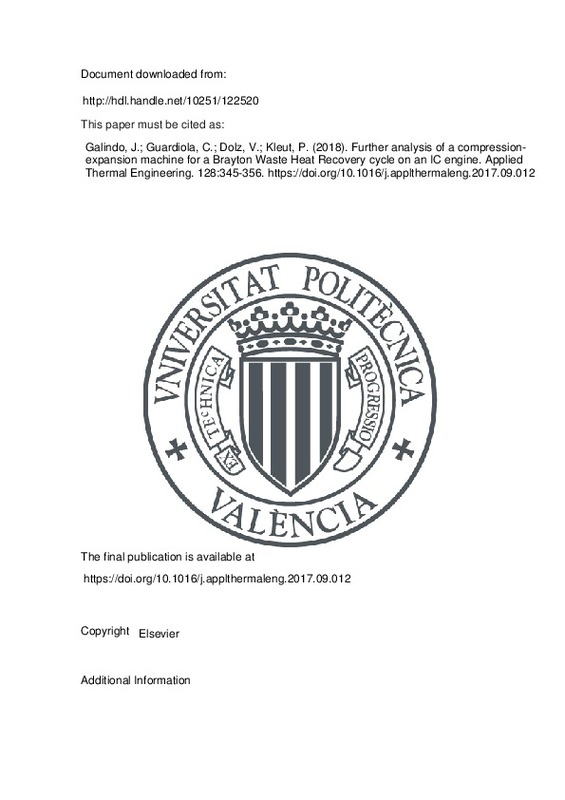JavaScript is disabled for your browser. Some features of this site may not work without it.
Buscar en RiuNet
Listar
Mi cuenta
Estadísticas
Ayuda RiuNet
Admin. UPV
Further analysis of a compression-expansion machine for a Brayton Waste Heat Recovery cycle on an IC engine
Mostrar el registro sencillo del ítem
Ficheros en el ítem
| dc.contributor.author | Galindo, José
|
es_ES |
| dc.contributor.author | Guardiola, Carlos
|
es_ES |
| dc.contributor.author | Dolz, Vicente
|
es_ES |
| dc.contributor.author | Kleut, Petar
|
es_ES |
| dc.date.accessioned | 2019-06-21T20:03:44Z | |
| dc.date.available | 2019-06-21T20:03:44Z | |
| dc.date.issued | 2018 | es_ES |
| dc.identifier.issn | 1359-4311 | es_ES |
| dc.identifier.uri | http://hdl.handle.net/10251/122520 | |
| dc.description.abstract | [EN] In order to comply with the legislation, car manufacturers are looking for a way to lower the CO2 emission by improving engine efficiency. About one third of the fuel combustion energy is wasted through exhaust gasses. Waste Heat Recovery (WHR) could improve engine efficiency by recovering a part of exhaust gasses energy. In this study, the potential use of an open loop Brayton cycle with a volumetric compression expansion machine for exhaust gas waste heat recovery was investigated. The use of the Brayton cycle system with only two main elements, a heat exchanger and a volumetric machine, could be very interesting due to its compactness and versatility. However, the publications on this subject are scarce. The present paper aims at bridging this knowledge gap by studying the cycle viability for passenger car application characterized by low temperatures, variable working conditions and several restrictions of available space and weight. The simulated vehicle was a Ford Mondeo family car with an Ecoboost 2.0 engine. The main components of the Brayton cycle WHR system model were a heat exchanger and an alternating piston machine that was used both as a compressor and as an expander. Theoretical studies were conducted in the compression-expansion machine model in order to determine the main parameters that influence the cycle and optimize those parameters in order to obtain the maximum recuperated power. The conclusion was that the cycle viability is not clear because cycle losses are in the same order of magnitude as the recuperated power. Considering future improvements of the compression-expansion machine and the heat exchanger, the recuperated power could be positive. Nevertheless, it is hard to expect that recuperated power would be sufficient to justify the application of this WHR system in the vehicle. (C) 2017 Elsevier Ltd. All rights reserved. | es_ES |
| dc.language | Inglés | es_ES |
| dc.publisher | Elsevier | es_ES |
| dc.relation.ispartof | Applied Thermal Engineering | es_ES |
| dc.rights | Reconocimiento - No comercial - Sin obra derivada (by-nc-nd) | es_ES |
| dc.subject | Brayton cycle | es_ES |
| dc.subject | Waste heat recovery | es_ES |
| dc.subject | WHR | es_ES |
| dc.subject | Internal combustion engine | es_ES |
| dc.subject.classification | MAQUINAS Y MOTORES TERMICOS | es_ES |
| dc.title | Further analysis of a compression-expansion machine for a Brayton Waste Heat Recovery cycle on an IC engine | es_ES |
| dc.type | Artículo | es_ES |
| dc.identifier.doi | 10.1016/j.applthermaleng.2017.09.012 | es_ES |
| dc.rights.accessRights | Abierto | es_ES |
| dc.contributor.affiliation | Universitat Politècnica de València. Departamento de Máquinas y Motores Térmicos - Departament de Màquines i Motors Tèrmics | es_ES |
| dc.description.bibliographicCitation | Galindo, J.; Guardiola, C.; Dolz, V.; Kleut, P. (2018). Further analysis of a compression-expansion machine for a Brayton Waste Heat Recovery cycle on an IC engine. Applied Thermal Engineering. 128:345-356. https://doi.org/10.1016/j.applthermaleng.2017.09.012 | es_ES |
| dc.description.accrualMethod | S | es_ES |
| dc.relation.publisherversion | https://doi.org/10.1016/j.applthermaleng.2017.09.012 | es_ES |
| dc.description.upvformatpinicio | 345 | es_ES |
| dc.description.upvformatpfin | 356 | es_ES |
| dc.type.version | info:eu-repo/semantics/publishedVersion | es_ES |
| dc.description.volume | 128 | es_ES |
| dc.relation.pasarela | S\342772 | es_ES |







![[Cerrado]](/themes/UPV/images/candado.png)

